By Sarah Yeoman | 8-minute read
No area in Oregon is immune to housing shortages, but the obstacles and needs rural Oregon faces in getting housing built differ from more urban areas. “One of the successful necessities in rural Oregon is when you wear more than one hat at a time to create housing,” says Gust Tsiatsos, owner of GCT Land Management. Gust is the developer of a cottage cluster in La Grande, renting to veterans who otherwise might struggle to find housing that accommodates their unique needs. The 10 colorful cottages sit on an unassuming street, facing inward toward a common parking area, creating a semi-private community – on a lot that once held just a single home – while still fitting right in with the neighborhood.
As Oregon’s housing shortage continues, developers across the state are exploring the opportunities of constructing what’s often called missing middle housing: duplexes, triplexes, townhomes, cottage clusters, and other starter housing that can tuck into existing neighborhoods and give people more choices when it comes to how and where they live. These homes with smaller footprints can be built more efficiently with fewer materials in a shorter timeframe, good for developers and environmental impact. “There are just more living units being built in, say, in a 16-month period as compared to one larger, more expensive home,” Gust says.
The cottage cluster model eases neighbors’ worries about change: “[It’s] something that these developments can get around because they blend well with other neighborhoods,” says Gust, a developer of rural housing for veterans
His company applied to fund the site through Oregon Housing Community Services, and now acts as the landlord of the property, working with Veterans Affairs to serve tenants. The modular cottages GCT builds are also adaptable to a wider array of demographics and living situations. For example: “Being 480 square feet, they are able to be used by a student. They're affordable to a student and actually fit that population,” Gust says. They’re also suitable for Oregon’s growing retired and elderly population as an option to age in place and downsize.
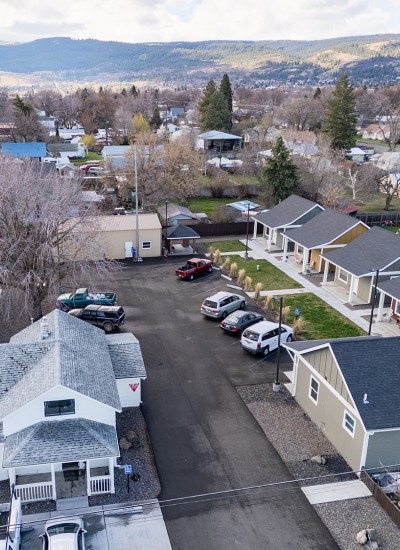
Across the state, in Eugene, a similar development is in progress, led by the firm Cultivate, which focuses on affordable and sustainable housing. Hadley Carlberg, an architectural designer at the firm, says Eugene’s large single-family lots present a good opportunity for middle housing development in a midsized city facing a harsh housing crisis. “A lot of people are struggling that there’s only single-family homes in a majority of Eugene, and people can’t afford it,” she says. Home to the University of Oregon, Eugene’s rental market tends to cater to students. “We don’t have a lot of support in other ways,” Hadley says.
The Cultivate project will have six three-story homes facing in toward a shared garden and pathway, similar to GCT’s veteran village. Even though construction is only partially finished, Cultivate has already sold one of the homes. “This house was the only one that I found that was in a price range that I thought I could manage and was also in the neighborhood I wanted to be in,” says Jake Harder, a 34-year-old first-time buyer who purchased in November 2024. For Jake, the home is pretty much perfect – it’s a 15-minute bike ride from the elementary school where he teaches sixth-grade Spanish, it’s around the corner from a grocery store, and it was built with energy efficiency and sustainability in mind. “I looked at a few other houses, and they were much more expensive than this and in less desirable shape,” he says. “This is new construction. To get a new house, it’s pretty awesome.”
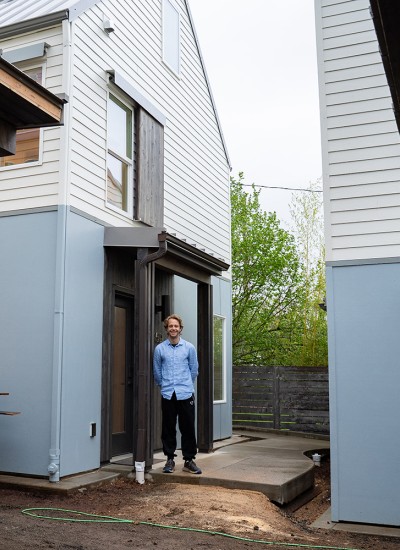
Community-building within neighborhoods is another feature of cottage cluster development that can foster healthy living, and one that both the Cultivate and GCT projects support. Dennis Scudder, a 65-year-old Army veteran who has lived in the La Grande veteran village for four years, says it’s been helpful to live in a place with support from others who have been through similar experiences. At the same time, compared to other assisted housing he’s lived in, it’s nice to have a space to himself. “You’ve got your own individual house, your own washer and dryer,” he says. “Just living in a community with other people, it’s all right around here.”
“I love that idea of going to the community that I both live and work in and just feeling a lot more connected than having to drive in my car on the freeway for an hour in traffic,” says Jake, a new homeowner
Jake in Eugene is looking forward to having new neighbors when the Cultivate project is finished, and to get to know his pocket community. “I love that idea of going to the community that I both live and work in and just feeling a lot more connected than having to drive in my car on the freeway for an hour in traffic,” he says.
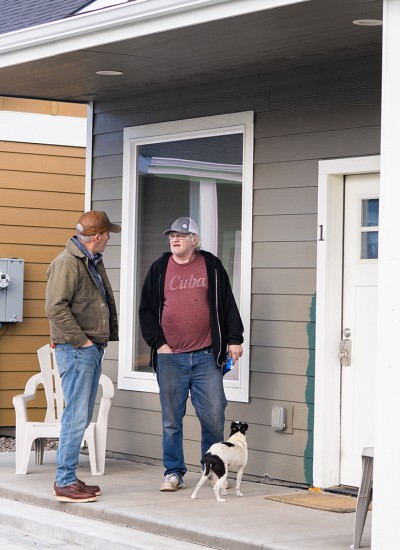
The cottage cluster model in particular, Gust says, works well for circumventing hesitation from longtime neighbors worried about change: “[It’s] something that these developments can get around because they blend well with other neighborhoods.… We recognize that the process of ‘not in my backyard’ is real,” says Gust. “We've had to figure out how to step over that issue, especially in rural communities where folks like things the way they have been and are oftentimes not as interested in change.” Hadley says Cultivate is trying to show neighborhoods how middle housing doesn’t need to be invasive. “We're trying to advocate for an aesthetic and a community style that is more inclusive, and has more of an opportunity.”
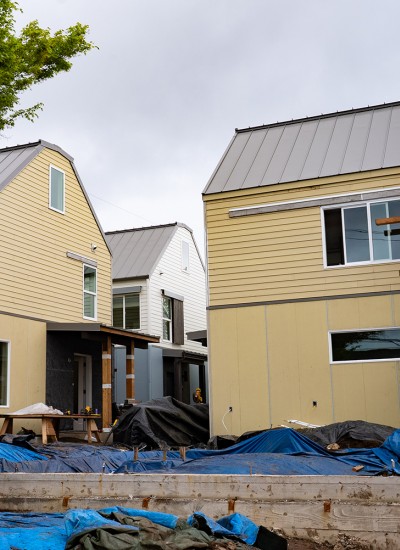
To get housing built quickly, developers of middle housing also need to navigate local permitting and zoning ordinances that might be outdated or causing unnecessary red tape. Despite Oregon’s 2019 historic passage of House Bill 2001 to allow innovative infill housing, local jurisdictions can present barriers that deter developers from starting or following through with projects – one of the reasons 1000 Friends of Oregon is supporting this year’s HB 2138, which will help remove local barriers to building, and part of why we’re launching Oregon for Everyone, a program to bring together a diverse coalition of individuals, community organizations, and local businesses to advocate for housing solutions that work. “House Bill 2001 just came into play. So it's so new that people just don’t know how to adjust the laws to make way for this new type of housing,” Hadley says.
“One of the glitches we have in rural housing is we don’t have the contractors to build multiple-story apartment buildings. We have to find ways to get housing but in small communities,” Gust says. The cottage cluster model works well, he says, because it’s a simple and nimble design that can be put on lots with unconventional sizing or restrictions, and uses the skill sets of workers that already exist in the area. While he says he wasn’t familiar with cottage clusters before GCT started building them, he sees them as a boon for the region that has real value. “We’ve opted to stay working in that realm where we can replicate small-footprint living in many communities.”
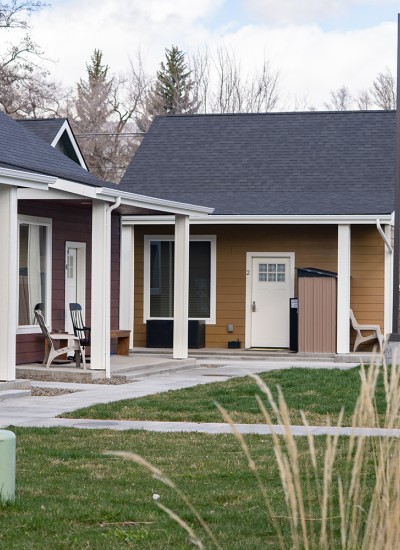
In Eugene, sustainability is a priority for Cultivate’s developments. “Combatting sprawl to mitigate climate change is really important,” Hadley says. Sprawl means developing bigger houses, road infrastructure, and all the support systems that go along with that in a larger scope of area. Middle housing has smaller footprints and uses fewer materials with support systems that are implemented closer together. “We can have construction happen at the same time,” Hadley says. “The health-oriented aspect is really important to us when building.”
“Combatting sprawl to mitigate climate change is really important,” says Hadley, an architectural designer in Eugene
Finding the balance in the intersections of sustainability, construction streamlining, and affordability in communities where Oregonians want to build their lives is challenging, but projects led by developers like GCT and Cultivate are showing it can be done successfully. “I feel like, a lot of times in rural communities, especially, where change isn't really sought after, having information that can be shared can tip people off of the balance of just being satisfied with the status quo,” Gust says. Sometimes it means creating momentum for middle housing through shared values. Cultivate’s owner, Dylan Lamar, funded their first middle housing project through grassroots initiatives – grabbing coffee with potential investors and bringing them on board with the social good of this type of housing. “He really did it single handedly,” Hadley says. “I think it was a good precedent and something that we'll do in the future.”
The benefits of creating middle housing will have a long-lasting effect on residents who may have otherwise been left out of workable and walkable neighborhoods, or priced out of the potential of homeownership altogether. “I'm a public schoolteacher, and I think it just makes it more possible for more people to get into the housing market,” Jake says. “It’s no easy feat, homeownership. But this type of housing development helped me make it possible.”
